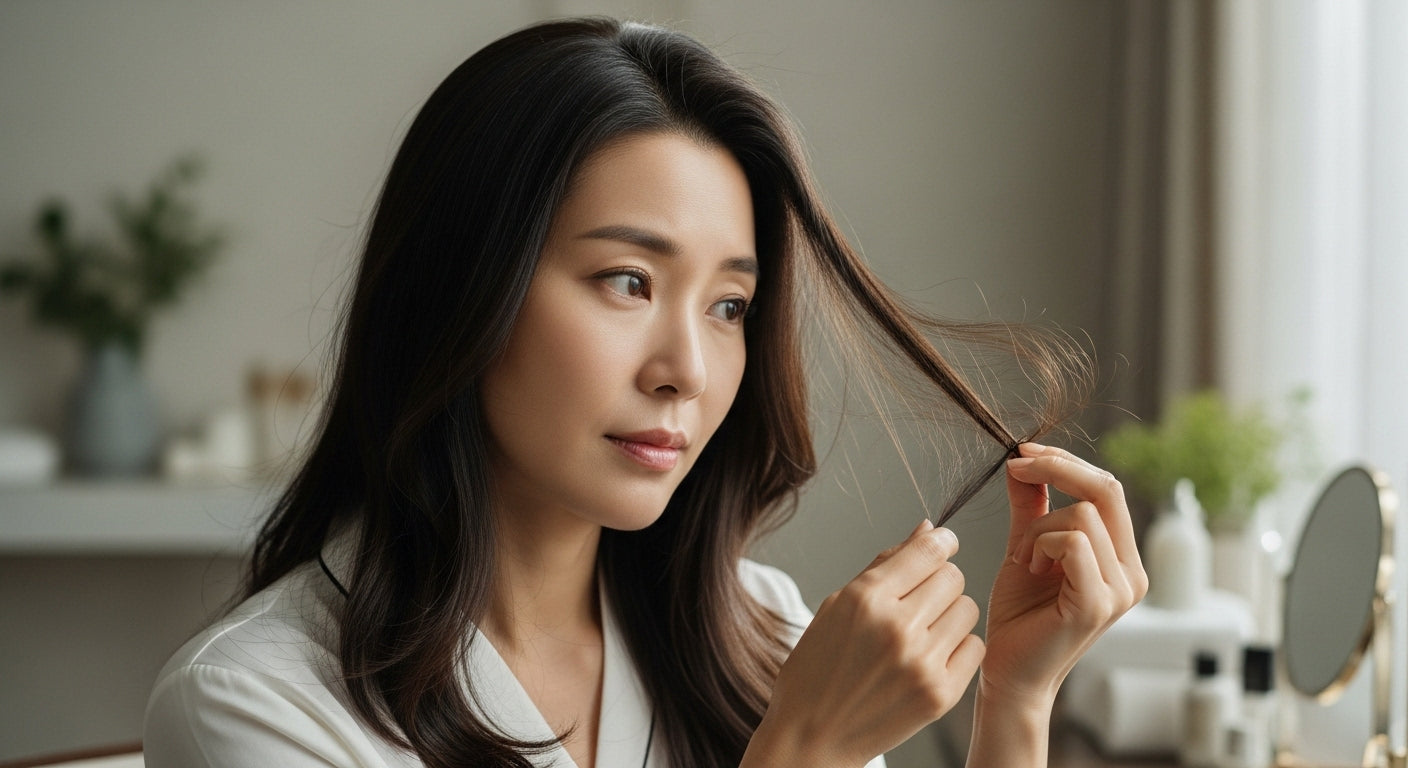Table of contents

Experiencing hair loss is not solely about the physical strands of hair that are disappearing.
Every hair that falls out tells a bigger story—usually tied to stress, hormonal changes, lifestyle issues, and emotional pressure. A lot of people going through this silently question whether there’s more behind it than just genetics or the products they use.
There is. And getting better starts with realizing what’s happening under the surface.
Whether you're navigating the challenges of postpartum recovery, experiencing the changes of perimenopause, coping with chronic stress, or simply feeling a bit off, it's important to focus on your well-being. The fact is that your hair can be a mirror of your internal health. When things are not quite right, your scalp and hair follicles are often the first to reveal the imbalance.
The Stress–Hair Loss Connection: How Cortisol Impacts Your Scalp


Stress is not solely an emotional experience; it has physical implications as well. When stress persists over an extended period, your body shifts its focus to survival mechanisms, sidelining non-essential functions such as hair growth. This is where cortisol, the primary hormone associated with stress, becomes significant.
When cortisol is elevated, it messes with the natural hair growth cycle, leading to more strands shifting into the telogen (shedding) phase. This is why many individuals experiencing extended stress observe more hair loss, particularly near the temples or crown.
You might notice:
- A quick rise in hair shedding during showers or found on pillows
- Narrower ponytails or expanded parting
- A scalp that is dry, tight, or has an itchy feeling
- An impression that your hair feels less strong, more fine, or more brittle
Telogen Effluvium is the name of this condition, and while it's often temporary, it can last for months if the stressors behind it aren't tackled.
On top of that, stress hampers blood flow to the scalp, weakens the skin's protective barrier, and disturbs the balance of your scalp microbiome—resulting in a situation where hair follicles have a tough time thriving.
Hormones and Hair Health: A Delicate Balance

Another significant cause of hair loss is hormonal changes, especially among women. Reproductive shifts and endocrine disorders can lead to fluctuations in hormones that directly influence hair growth, how long it remains in the growth phase, and how fast it sheds.
Typical triggers include:
- Postpartum hormonal crash: Following delivery, estrogen levels fall sharply, frequently resulting in a postponed shedding phase.
- PCOS (Polycystic Ovary Syndrome) or insulin resistance: Can increase androgens such as DHT, causing follicles to shrink and resulting in thinning.
- Perimenopause or menopause: As estrogen and progesterone levels drop, you might notice a reduction in hair density.
- Thyroid dysfunction: Both conditions, hypothyroidism and hyperthyroidism, can change the quality and fullness of your hair.
The role of hormones:
- Estrogen and progesterone contribute to prolonged growth cycles and boost fullness.
- DHT (dihydrotestosterone) is a kind of androgen that shortens the growth phase and causes follicles to become miniaturized.
If hormonal hair loss is not properly managed, it typically presents itself as a slow and steady thinning of the hair, a noticeable reduction in volume, and an extended period for hair to regrow after shedding.
A Deeper Philosophy: Wellness As the First Step Toward Recovery

At the core of any meaningful transformation is the belief that healing is possible; however, it is essential for this healing to take place both within ourselves and in the world around us.
Instead of merely tackling the symptoms, a wellness-oriented strategy emphasizes the complete environment that aids hair growth: the health of the scalp, stress management, nutrient supply, hormonal balance, and emotional health.
A Multi-dimensional Approach to Hair Recovery


It's not solely about shampoo or supplements. Authentic recovery occurs through an all-encompassing strategy that nurtures the body from the inside out.
1. Scalp Therapy to Rebalance and Renew
The scalp is essentially a type of skin, much like the skin on your face. It accumulates various substances such as oils, sweat, hair products, and environmental pollutants. If this buildup is not addressed, it can lead to clogged hair follicles, which may impede the growth of new hair.
A personalised scalp therapy session usually kicks off with:
Utilising a trichoscope for the purpose of performing a digital examination of the scalp.
Treatments for cleansing with herbal foam or oxygenated water
Natural exfoliation using botanicals to eliminate dead skin and impurities
Steam therapy for softening buildup and increasing absorption
This is beneficial:
Purify the scalp to promote a healthy environment for hair growth.
Improve microcirculation
Alleviate inflammation
The foundation of healthy growth lies in the quality of prime follicles.
2. LED Therapy to Stimulate Follicle Function
Using specific wavelengths, low-level light therapy (LLLT) aims to:
Encourage those dormant follicles to spring into action!
Accelerate the metabolic processes within cells
Hasten the repair process for tissues
Stretch out the anagen (growth) phase
This method is safe and non-invasive, especially effective when used alongside active serums or scalp infusions.
3. Botanical Concentrates to Nourish and Fortify
These infusions, loaded with ginseng, niacinamide, biotin, and plant-sourced peptides, deliver deep nourishment straight to the roots.
These ingredients provide assistance:
Invigorate the scalp to promote healthy hair growth.
Increase the quantity of hair follicles
Revitalize your hair's texture and fortify its strength.
Foster your personal strength and resilience.
4. Rituals That Rewire the Stress Response
The condition of your hair is closely linked to the health of your nervous system. This connection highlights the importance of engaging in therapeutic rituals, which play a crucial role in the recovery process.
Scalp massages using aromatherapy, gentle pressure-point methods, and optional heated eye masks all work in harmony to:
Lower the levels of cortisol
Increase your vagal tone for enhanced well-being.
Facilitate a level of relaxation that is both profound and restorative.
Develop a peaceful environment and consistent emotional steadiness.
Why Scalp Health is Often Overlooked—But Essential

The skin on your scalp contains more sebaceous glands and larger follicles than any other area of your body. Surprisingly, most people just forget about it.
When your scalp isn't in good shape, it can cause:
Congestion in the follicles
Diminished delivery of oxygen and nutrients
Inflammation and sensitivity of the scalp
The process of regrowth is characterized by a weaker strength and an extended duration.
A healthy scalp is the starting point for healthy hair.Looking after it isn’t a luxury—it’s the groundwork.
The Lifestyle Equation: How Daily Choices Impact Hair


The process of hair growth is slow — and your daily routines have a significant effect on it.
What helps?
Nutritional Support : Incorporate foods into your diet that are known for their high content of Omega-3s, iron, zinc, and vitamin D to ensure you meet your nutritional needs.
Adaptogens : Ashwagandha, rhodiola, and holy basil are powerful herbs that contribute to the modulation of stress, promoting a sense of calm and balance.
Scalp Massage at Home : Taking just 3 to 5 minutes a day can enhance circulation and soothe the nervous system.
Mindfulness and Sleep : Prioritize achieving 7 to 9 hours of restorative sleep each night, and consider incorporating practices like journaling, meditation, or yoga nidra into your routine.
All these choices contribute to regulating your neuroendocrine system, enhancing cellular health, and establishing an environment where your hair can genuinely thrive.
When Should You See a Specialist?

If you've been dealing with hair loss for more than three months, or if it happens to align with:
A sense of depletion
Hormonal pimples are blemishes that develop due to changes in hormone levels, often linked to menstrual cycles, pregnancy, or hormonal disorders.
Non-standard cycles
Mood changes
Rapid weight fluctuations
...it's the right time to get in touch with a trichologist or an integrative practitioner.
Early detection can avoid permanent damage to your follicles. With the right assistance, you can get back on your feet—emotionally and physically.
Final Thoughts: You Are Not Alone

Experiencing hair loss is an incredibly personal matter for many individuals. It often ties closely to their self-esteem, identity, and overall emotional well-being. However, it’s important to recognize that hair loss is a widespread issue, and in numerous cases, it can be effectively treated or even completely reversed.
This goes beyond just hiding the symptoms. The real challenge lies in identifying and addressing the root causes, fostering internal growth, and treating yourself with the kindness you deserve.
Healing isn't just a possibility—it's pretty much a guarantee when you provide your body with what it genuinely requires.
FAQs: Frequently Asked Questions
1. Can stress alone really cause noticeable hair loss?
Absolutely! Long-term stress can disrupt your hair growth cycle, often leading to hair loss called telogen effluvium, where many hairs shed at once. This type of hair loss may not appear immediately; it can take weeks or even months, but the good news is it is usually temporary and manageable.
2. How do I know if my hormones are causing my hair loss?
When it comes to hormonal hair loss, it typically develops gradually. Common signs of hair loss include thinning at the crown, a more noticeable hairline, or a general decrease in hair volume. It may also be accompanied by symptoms such as acne, irregular periods, or weight gain. Blood tests and a scalp examination can help identify the underlying cause of the hair loss.
3. Are scalp treatments enough to reverse hair loss?
Common signs of hair loss include unexpected shedding, noticeable thinning around the crown or temples, a dry or flaky scalp, and worsening hair loss during times of emotional or physical stress.
4. How long does it take to see results from a hair loss wellness approach?
The outcome of hair loss really depends on its severity and underlying cause. Some people may notice reduced hair loss within 4 to 6 weeks, while seeing new hair growth can take 2 to 3 months or longer, especially if hormonal factors are involved. Staying consistent with care is essential.
5. What should I avoid if I’m experiencing hair loss?
If your hair loss continues for more than three months or worsens, especially alongside hormonal imbalances, it is important to consult a trichologist or holistic practitioner. They can help identify the root causes of hair loss and create a personalized recovery plan to address your specific needs.


Share:
The Wellkin Scalp Reset: A Multi-Step Korean Therapy
Scalp Treatment vs Hair Treatment: Building the Foundation for Strong, Radiant Hair